AMD Athlon 64 FX-60: A Dual-Core farewell to Socket-939
by Anand Lal Shimpi on January 9, 2006 11:59 PM EST- Posted in
- CPUs
AMD's Socket-939 has been the platform of choice almost immediately after its introduction, so it is fitting that the last Socket-939 processor to be released would be the Athlon 64 FX-60.
After today's launch of the FX-60, there will be no faster Socket-939 CPUs produced. Instead, everything else will be Socket-AM2 (the new name for Socket-M2). Next quarter, AMD will launch their Socket-AM2 platform along with AM2 versions of the Athlon 64, Athlon 64 X2 and the FX-62. Given that the AM2 platform adds DDR2 support, it is entirely feasible that the Athlon 64 FX-62 won't receive a clock speed bump over the FX-60 and just use the higher bandwidth memory as justification for the higher model number.
Although we've generally shied away from recommending AMD's FX line of processors, we can't help but be a little excited about the FX-60. When AMD introduced their X2 line of dual-core processors, the FX series remained single core, but maintained a fairly high clock speed. AMD even went as far as to release the FX-57, clocked a full 400MHz higher than the fastest X2. With the FX-60, that trend is over; from this day forward, all members of the FX series of processors are now dual core. They are still sold under the Athlon 64 FX brand, despite being dual core chips.
Our excitement over the Athlon 64 FX-60 isn't really about its performance, although at 2.6GHz it is quite stellar; rather, it is more of an excitement out of principle. We've favored and recommended dual core processors to power users as soon as they were available, even though dual core processors were generally far slower at single-threaded applications than their equivalently priced single core alternatives. With the FX-60, at least at the high end, the same is no longer true.
The fastest single core AMD processor is still the Athlon 64 FX-57 running at 2.8GHz, which AMD will continue to sell alongside the FX-60. But with the clock speed gap between the 2.6GHz dual core FX-60 and the 2.8GHz single core FX-57 a meager 7.6%, you can effectively go to one CPU and get the best single-threaded and multithreaded performance. Remember that the best applications that scale with clock speed generally give you a 50% return on every 100% increase in clock speed, so in most of the single-threaded cases, the FX-57's performance advantage will be in the 0 - 4% range. But on the flip side, the fact that the FX-60 is a dual core processor will buy it a lot in multithreaded applications.
As with all FX series processors, the FX-60 debuts at $1031 in quantities of 1000, so you can expect street pricing to be at or around that number. The FX-57 will drop to $827 mark as it will co-exist with the FX-60.
The FX-60 is really just a multiplier unlocked 2.6GHz Athlon 64 X2. It is still a 90nm processor and there are no architectural changes that we've been made aware of or have been able to find on our own. We stress the point that it is still a 90nm chip because of the fact that its closest competitor, the Pentium Extreme Edition 955, just debuted on Intel's 65nm process. Because Intel is on a smaller manufacturing process, they can cram more transistors into a smaller space. So although the Pentium EE 955 is a 376-million transistor chip, they only take up 162 mm2 of space. The Athlon 64 FX-60 by comparison is a 233-million transistor chip, but its die is a larger 199 mm2. The move to 65nm for AMD should cut the die size roughly in half assuming no architectural changes, but until then, Intel will at least have the manufacturing advantage.
You shouldn't, however, assume that the smaller, cooler running manufacturing process will result in a power advantage for Intel. The problem is that those 376 million transistors are used to build a beast of a chip with a 31-stage pipeline, so power consumption is still actually higher on the Extreme Edition than on AMD's fastest dual core:
After today's launch of the FX-60, there will be no faster Socket-939 CPUs produced. Instead, everything else will be Socket-AM2 (the new name for Socket-M2). Next quarter, AMD will launch their Socket-AM2 platform along with AM2 versions of the Athlon 64, Athlon 64 X2 and the FX-62. Given that the AM2 platform adds DDR2 support, it is entirely feasible that the Athlon 64 FX-62 won't receive a clock speed bump over the FX-60 and just use the higher bandwidth memory as justification for the higher model number.
Although we've generally shied away from recommending AMD's FX line of processors, we can't help but be a little excited about the FX-60. When AMD introduced their X2 line of dual-core processors, the FX series remained single core, but maintained a fairly high clock speed. AMD even went as far as to release the FX-57, clocked a full 400MHz higher than the fastest X2. With the FX-60, that trend is over; from this day forward, all members of the FX series of processors are now dual core. They are still sold under the Athlon 64 FX brand, despite being dual core chips.
Our excitement over the Athlon 64 FX-60 isn't really about its performance, although at 2.6GHz it is quite stellar; rather, it is more of an excitement out of principle. We've favored and recommended dual core processors to power users as soon as they were available, even though dual core processors were generally far slower at single-threaded applications than their equivalently priced single core alternatives. With the FX-60, at least at the high end, the same is no longer true.
The fastest single core AMD processor is still the Athlon 64 FX-57 running at 2.8GHz, which AMD will continue to sell alongside the FX-60. But with the clock speed gap between the 2.6GHz dual core FX-60 and the 2.8GHz single core FX-57 a meager 7.6%, you can effectively go to one CPU and get the best single-threaded and multithreaded performance. Remember that the best applications that scale with clock speed generally give you a 50% return on every 100% increase in clock speed, so in most of the single-threaded cases, the FX-57's performance advantage will be in the 0 - 4% range. But on the flip side, the fact that the FX-60 is a dual core processor will buy it a lot in multithreaded applications.
As with all FX series processors, the FX-60 debuts at $1031 in quantities of 1000, so you can expect street pricing to be at or around that number. The FX-57 will drop to $827 mark as it will co-exist with the FX-60.
The FX-60 is really just a multiplier unlocked 2.6GHz Athlon 64 X2. It is still a 90nm processor and there are no architectural changes that we've been made aware of or have been able to find on our own. We stress the point that it is still a 90nm chip because of the fact that its closest competitor, the Pentium Extreme Edition 955, just debuted on Intel's 65nm process. Because Intel is on a smaller manufacturing process, they can cram more transistors into a smaller space. So although the Pentium EE 955 is a 376-million transistor chip, they only take up 162 mm2 of space. The Athlon 64 FX-60 by comparison is a 233-million transistor chip, but its die is a larger 199 mm2. The move to 65nm for AMD should cut the die size roughly in half assuming no architectural changes, but until then, Intel will at least have the manufacturing advantage.
You shouldn't, however, assume that the smaller, cooler running manufacturing process will result in a power advantage for Intel. The problem is that those 376 million transistors are used to build a beast of a chip with a 31-stage pipeline, so power consumption is still actually higher on the Extreme Edition than on AMD's fastest dual core:












94 Comments
View All Comments
Betwon - Tuesday, January 10, 2006 - link
Yes, It is well known that P4 need more power than X2, but P4 is still able to overclock.While X2 need less power than P4, but both of them(anand & xbitlabs) find that they can't OC X2 any more (15X).
Betwon - Tuesday, January 10, 2006 - link
In fact, those tests show that:X2 is overclocked in those benchmarks still slower then P4.
We find the truth.
Without OC:
955 is 3.46GHz, FX-60 is 2.6GHz --> the ratio is 1.33 (3.46/2.6). -->In most tests, X2 is better than P4.
OC:
955 is 4.26GHz, FX-60 is 2.9GHz -->Now, the ratio is 1.46 (4.26/2.9). -->P4 starts to be better than X2.
It is very simple:
The ratio
flyck - Tuesday, January 10, 2006 - link
p4 wins one test the others it is way behind. you reversed it. p4 overclocked is still slower in those benchmarks.
overclocked
FX 2.8/ FX 2.6/ XE 4.266
UT 2004 : 95.8 / 90.5 / 82.4
Cinebench : 963 / 891 / 928
only tests they did overclocked. p4 wins none of them. it is just edges above or around the normal FX 60.
ow yeah your ratio... you have found a way for perfect scaling ? great, there will be people intrested....
not even talking about the fact that your primary ratio is wrong because @ those frequencys p4 wins nonthing, so is not even equal. and oced is comes close it will probably win some and lose some (like in those 2 test) so then they are about equal.
so the more accurate ratio will be 1.40-1.50. for equal performance. in which case p 4 should run above 4.5GHz before it has a noticeable gap over the FX60 overall.....
Betwon - Tuesday, January 10, 2006 - link
P4 better than X2.Ratio is the key.
The ratio below 1.33 -- P4 is behide.
ratio above 1.4x -- P4 is competitive. Intel 4.26GHz VS AMD 2.9GHz
For the ratio of intel 820 VS AMD 3800+ 165 170? see the benchmark of spec cpu2000 rates for 2 core 1 chip:
The float point performance(under windows OS/32-bit):
PD 820 SPECfp_rate_base2000 29.9 SPECfp_rate2000 30.0
http://www.spec.org/osg/cpu2000/results/res2005q4/...">http://www.spec.org/osg/cpu2000/results/res2005q4/...
170(939-pin 2GHz 1MX2) SPECfp_rate_base2000 25.2 SPECfp_rate2000 26.3
http://www.spec.org/osg/cpu2000/results/res2005q4/...">http://www.spec.org/osg/cpu2000/results/res2005q4/...
We don't find the benchmark of 165 and 3800+, but we find the benchmark of 175.
170(939-pin 2.2GHz 1MX2) SPECfp_rate_base2000 26.2 SPECfp_rate2000 27.3
http://www.spec.org/osg/cpu2000/results/res2005q3/...">http://www.spec.org/osg/cpu2000/results/res2005q3/...
We don't find the benchmark of both PD and X2/opteron dc under windows OS/64bit, so we can not compare the dual-core float point performance 64-bit directly.
The test--SPECfp_rate is the most important test for CPU float performance. AMD approbate SPECfp_rate for testing dual-core's FP performance.AMD think it is a fair test.
Betwon - Tuesday, January 10, 2006 - link
Edit:175(939-pin 2.2GHz 1MX2) SPECfp_rate_base2000 26.2 SPECfp_rate2000 27.3
http://www.spec.org/osg/cpu2000/results/res2005q3/...">http://www.spec.org/osg/cpu2000/results/res2005q3/...
It is not 170.
flyck - Tuesday, January 10, 2006 - link
ProLiant DL145 G2 (AMD Opteron (TM) 275) 2 cores, 1 chip, 2 cores/chip 30.3 32.4Betwon - Tuesday, January 10, 2006 - link
We find the 270(2GHz) FP benchmark of 32-bit under windows OS.http://www.spec.org/osg/cpu2000/results/res2005q2/...">http://www.spec.org/osg/cpu2000/results/res2005q2/...
270(not 939-pin ) SPECfp_rate_base2000 27.1 SPECfp_rate2000 28.3
But PD820 SPECfp_rate_base2000 29.x SPECfp_rate2000 30.x
better
Now, ratio is 2.8/2=1.4.
Questar - Tuesday, January 10, 2006 - link
You know, I pretty much favor Intel chips, but I still wish you stop your ranting.Betwon - Tuesday, January 10, 2006 - link
You know, I do not favor Intel chips, and I wish you stop your favor of Intel.Because we know the spec is not favor of Intel, and AMD knew it.
Betwon - Tuesday, January 10, 2006 - link
rates275
It is FP benchmark under 64-bit and Linux, but not the FP benchmark under 32-bit and windows.
And 275 is 2.2GHz
PD820 is 2.8GHz
ratio: 2.8/2.2 = 1.22(only).